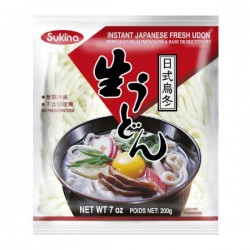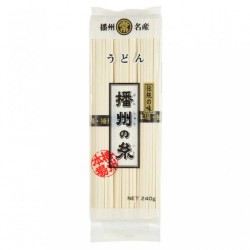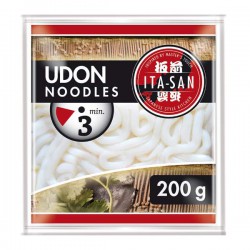Derfor har over 21.000 handlet her
Udon noodles
 Only Zealand & Lolland-Falster
Only Zealand & Lolland-Falster
Udon noodles - Japanese comfort food
Udon noodles originate from Japan; the thick noodle is made from wheat flour and is often used in soups. It can resemble pasta somewhat, particularly because of its size, which is significantly larger than other types of noodles. Udon noodles have been known for many years, but there is some uncertainty about how they first came about. Some believe that it was a Rinzai monk who, in 1241, introduced the Japanese to the ability to grind flour. This led them, among other things, to use the flour to make noodles.
Others argue that we must go further back, to 710–794, during the period known as Nara, when a group from Japan introduced the Chinese in the Tang dynasty to 14 different types of food, one of which was "muginawa" is not a standard Danish word. It may be a name, a misspelling, or a word from another language. If it's a proper name, leave it as "muginawa." Possible alternative: in Japanese, mugi (麦) = "barley/wheat" and nawa (縄) = "rope," so "muginawa" could be rendered as "barley rope" or "wheat rope." If you have context or a corrected spelling, I can give a more accurate translation., a dish that many believe was the predecessor to many types of noodles.
There are also stories circulating that udon noodles originate... konton → accounts (Note: "konton" is actually the Swedish plural of "konto"; in Danish the plural is usually "konti" or "kontoer".), ...which is a dish made with wheat flour and sweet filling. This is said to have developed into the udon noodles we know today. A fourth story claims that udon noodles were introduced by a Buddhist priest to the island of Shikoku. From there they are said to have spread to the rest of Japan.Historierne There are many stories, but regardless of how udon noodles came about, many of us enjoy those delicious wheat-flour noodles today. Many Japanese people eat udon in dishes that can be described as comfort food — food that is either nostalgic or has a high sentimental value, which is why it is especially pleasant to eat.
Udon noodles — go well in both cold and hot dishes.
Udon noodles are eaten both hot and cold, which makes them a very versatile base for many dishes. Cold udon dishes are typically salads, in which they are mixed with slices of omelette, chicken and fresh vegetables. A common feature of dishes that include udon noodles is that the noodles can also be replaced with soba noodles.
"The warm udon dishes can range from" (fragment — the sentence is incomplete). tempura udon — "udon with tempura", where tempura shrimp or kakiage (Refers to a Japanese tempura fritter made from mixed vegetables and/or seafood.) "used as a topping for the noodle soup, for..." (Note: this is a fragment/incomplete sentence in Danish.) chikara udon Literal meaning: "power udon" — a Japanese udon noodle dish often served with mochi (rice cake)., a noodle dish topped with toasted mochi rice cakes. Mochi are primarily known from the sweet kitchen, but they can also be used in savory cooking as part of a dish. However, these are not the mochi we know, because when used in savory dishes they usually don’t have sweet filling inside.
Another popular dish made with udon noodles is cold. tanuki udon (English: a Japanese udon noodle dish topped with tempura crumbs — tenkasu), which fortunately has nothing to do with the animal tanuki — a somewhat peculiar cross between a raccoon and a dog that comes from Japan. Tanuki udon is a cold dish in which the noodles are served with a cold broth, mentsuyu (English: mentsuyu — a Japanese noodle soup base/soup stock or concentrated dipping sauce, typically made from dashi, soy sauce and mirin.), which consists, among other things, of sake, mirin, soy sauce, kombu and katsuobushi — dried/fermented smoked skipjack tuna (bonito flakes), which are dried bonito flakes. In addition, toppings include, among other things tenkasu — "tempura scraps" (also called tempura flakes or agedama): small crunchy bits of deep-fried tempura batter used as a topping. Note: this is a Japanese culinary term, not Danish., which are small pieces of deep-fried tempura batter that are sprinkled on food to add a little extra crunch and texture - a bit like a crouton.
Many people also like to add fresh vegetables to it, such as cucumber, tomatoes, daikon (Chinese radish) and spring onions. A half hard‑boiled egg can be served with it to add protein to the dish. All in all, a simple dish that can be lovely to eat on a warm summer day when you have neither the appetite nor the energy for a big culinary adventure.
Udon noodles - From Japan to the rest of the world
Despite udon noodles originating in Japan, they have spread to much of the world. Looking more closely at the countries that have specific dishes with udon noodles, it is primarily countries near Japan that have warmly received the thick wheat noodles. For example, Korea has adopted the noodles, serving them in the traditional Japanese way and also giving them its own twist in a more Korean-sounding noodle soup.
The Philippines and Palau also have their own dishes based on udon noodles or noodles that closely resemble them in size and taste.
"Hos" — "at" or "with" (typically meaning "at someone's place" or "in the home of") Den Kinesiske Købmand You can get several different types of udon noodles, and it's one of those kinds of noodles that is often sold fresh. The advantage of buying the fresh noodles is that, like fresh pasta, they don't need to spend as long in boiling water before they're done. That way you can quickly prepare a tasty side or a base for your cooking. You can also choose to let the noodles cook in the soup — they will then absorb even more flavor.

 EN
EN
 DA
DA
 ZH
ZH
















